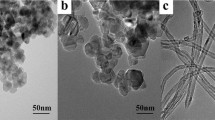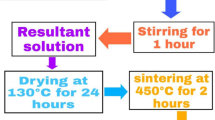Abstract
Carbon-based nano- and microfluid dispersions show promise as effective media for solar-assisted desalination. They act as strong solar absorbers in the base fluid and increase its temperature by volumetrically heating the bulk of the fluid, leading to faster vapor generation. This radiative heating depends on the fraction of the solar radiation absorbed by the fluid dispersion system. This in turn depends on the optical constants, i.e., refractive index and attenuation (absorption) coefficient of the particles. Different carbon materials exhibit different values of the optical constants when exposed to the solar spectrum and so, the evaporation efficiency is different for different particles. An attempt is made to explore the influence of these optical constants on the evaporation rate and evaporation efficiency of water. The values chosen are within the upper and lower bounds of the refractive index (\(1\le n \le 3\)) and attenuation coefficient (\(0.001\le k \le 1\)), which are typical of carbon-based materials. It was found that the evaporation rate is higher for large attenuation coefficient for any refractive index. Also, at a relative refractive index of 1, the solar absorption coefficient is comparatively smaller than for other values, due to lower scattering efficiency. At high refractive index, the evaporation efficiency remained almost constant for volume fractions less than \(10^{-4}\) (or 0.01%). In summary, water evaporation rate and evaporation efficiency are strongly influenced by the optical constants.







Similar content being viewed by others
Abbreviations
- \(A_{\mathrm{abs}}\) :
-
Surface area, \(\text{m}^2\)
- \(A_{\mathrm{sol}}\) :
-
Weighted solar absorption coefficient
- \(C_\mathrm{p}\) :
-
Specific heat capacity, J kg\(^{-1}\) K
- d :
-
Diameter of particle, \(2r_\mathrm{p}\), m
- \({D_\mathrm{{v,air}}}\) :
-
Diffusivity of vapor into air, \(\text{m}^{2}\text{s}^{-1}\)
- \({f_\mathrm{v}}\) :
-
Volume fraction
- \(h_\mathrm{{fg}}\) :
-
Enthalpy of Vaporization, J kg\(^{-1}\)
- K :
-
Thermal conductivity, W m\(^{-1}\) K
- k :
-
Attenuation (absorption) coefficient
- m :
-
Real part of relative complex refractive index
- \(\dot{m''}\) :
-
Rate of evaporation of water per unit of area, \(\text{kgm}^{-2} \text{s}\)
- n :
-
Refractive index
- \(Q_\mathrm{{sca,abs,ext}}\) :
-
Scattering, absorption and extinction efficiency of dispersion particle
- \({\dot{q}}'''\) :
-
Volumetric heat generation, \(\text{Wm}^{-3}\)]
- T :
-
Temperature, K
- X :
-
Size parameter
- \(\beta _\mathrm{ext}\) :
-
Extinction coefficient, \(\text{m}^{-1}\)
- \(\eta _\mathrm{evap}\) :
-
Evaporation efficiency
- \(\lambda\) :
-
Incident wavelength, nm
- \(\rho\) :
-
Density, \(\text{kg m}^{-3}\)
- \(\sigma\) :
-
Stefan-Boltzmann constant, \(5.67\times 10^{-8}\), \(\text{Wm}^{-2}\text{K}^4\)
- cond:
-
Conduction
- conv:
-
Convection
- np:
-
Nanoparticle
- p:
-
Particle
- rad:
-
Radiation
- w:
-
Water
References
Shannon MA, Bohn PW, Elimelech M, Georgiadis JG, Marin̈as BJ, Mayes AM. Science and technology for water purification in the coming decades. Nature. 2008;452:301. https://doi.org/10.1038/nature06599.
Ahmed FE, Hashaikeh R, Hilal N. Solar powered desalination—technology, energy and future outlook. Desalination. 2019;453:54. https://doi.org/10.1016/j.desal.2018.12.002.
Wang H. Low-energy desalination. Nat Nanotechnol. 2018;13:273. https://doi.org/10.1038/s41565-018-0118-y.
Wang W, Shi Y, Zhang C, Hong S, Shi L, Chang J, Li R, Jin Y, Ong C, Zhuo S, Wang P. Simultaneous production of fresh water and electricity via multistage solar photovoltaic membrane distillation. Nat Commun. 2019;. https://doi.org/10.1038/s41467-019-10817-6.
Gong B, Yang H, Wu S, Xiong G, Yan J, Cen K, Bo Z, Ostrikov K. Graphene array-based anti-fouling solar vapour gap membrane distillation with high energy efficiency. Nano-Micro Lett. 2019;11(1):51. https://doi.org/10.1007/s40820-019-0281-1.
Wang X, He Y, Liu X, Cheng G, Zhu J. Solar steam generation through bio-inspired interface heating of broadband-absorbing plasmonic membranes. Appl Energy. 2017;195:414. https://doi.org/10.1016/j.apenergy.2017.03.080.
Chen W, Chen S, Liang T, Zhang Q, Fan Z, Yin H, Huang KW, Zhang X, Lai Z, Sheng P. High-flux water desalination with interfacial salt sieving effect in nanoporous carbon composite membranes. Nat Nanotechnol. 2018;13:345. https://doi.org/10.1038/s41565-018-0067-5.
Das R, Ali ME, Hamid SBA, Ramakrishna S, Chowdhury ZZ. Carbon nanotube membranes for water purification: a bright future in water desalination. Desalination. 2014;336:97. https://doi.org/10.1016/j.desal.2013.12.026.
Ihsanullah. Carbon nanotube membranes for water purificatin: developments challenges and prospects for the future. Sep Purif Technol. 2019;209:307. https://doi.org/10.1016/j.seppur.2018.07.043.
Rizzuto C, Pugliese G, Bahattab MA, Aljlil SA, Drioli E, Tocci E. Multiwalled carbon nanotube membranes for water purification. Sep Purif Technol. 2018;193:378. https://doi.org/10.1016/j.seppur.2017.10.025.
Wang X, He Y, Liu X, Zhu J. Enhanced direct steam generation via a bio-inspired solar heating method using carbon nanotube films. Powder Technol. 2017;321:276. https://doi.org/10.1016/j.powtec.2017.08.027.
Dongare PD, Alabastri A, Pedersen S, Zodrow KR, Hogan NJ, Neumann O, Wu J, Wang T, Deshmukh A, Elimelech M, Li Q, Nordlander P, Halas NJ. Nanophotonics-enabled solar membrane distillation for off-grid water purification. Proc Natl Acad Sci. 2017;114(27):6936. https://doi.org/10.1073/pnas.1701835114.
Abu-Arabi M. status and prospects for solar desalination in the mena region. In: Rizzuti L, Ettouney HM, Cipollina A, editors. Solar desalination for the 21st century. Dordrecht: Springer; 2007. p. 163–78.
Sharshir SW, Peng G, Wu L, Yang N, Essa FA, Elsheikh AH, Mohamed SIT, Kabeel AE. Enhancing the solar still performance using nanofluids and glass cover cooling: experimental study. Appl Therm Eng. 2017;113:684. https://doi.org/10.1016/j.applthermaleng.2016.11.085.
Panchal H, Sathyamurthy R, Kabeel AE, El-Agouz SA, Rufus D, Arunkumar T, Muthu Manokar A, Winston DP, Sharma A, Thakar N, Sadasivuni KK. Annual performance analysis of adding different nanofluids in stepped solar still. J Therm Anal Calorim. 2019;. https://doi.org/10.1007/s10973-019-08346-x.
Bait O, Si-Ameur M. Enhanced heat and mass transfer in solar stills using nanofluids: a review. Sol Energy. 2018;170:694. https://doi.org/10.1016/j.solener.2018.06.020.
Wang X, He Y, Chen M, Hu Y. ZnO–Au composite hierarchical particles dispersed oil-based nanofluids for direct absorption solar collectors. Sol Energy Mater Sol Cells. 2018;179:185. https://doi.org/10.1016/j.solmat.2017.11.012.
Wang X, He Y, Liu X. Synchronous steam generation and photodegradation for clean water generation based on localized solar energy harvesting. Energy Convers Manag. 2018;173:158. https://doi.org/10.1016/j.enconman.2018.07.065.
Wang X, He Y, Liu X, Shi L, Zhu J. Investigation of photothermal heating enabled by plasmonic nanofluids for direct solar steam generation. Sol Energy. 2017;157:35. https://doi.org/10.1016/j.solener.2017.08.015.
Ni G, Miljkovic N, Ghasemi H, Huang X, Boriskina SV, Lin CT, Wang J, Xu Y, Rahman MM, Zhang T, Chen G. Volumetric solar heating of nanofluids for direct vapor generation. Nano Energy. 2015;17:290. https://doi.org/10.1016/j.nanoen.2015.08.021.
Neumann O, Urban AS, Day J, Lal S, Nordlander P, Halas NJ. Solar vapor generation enabled by nanoparticles. ACS Nano. 2013;7(1):42. https://doi.org/10.1021/nn304948h PMID: 23157159.
Liu X, Wang X, Huang J, Cheng G, He Y. Volumetric solar steam generation enhanced by reduced graphene oxide nanofluid. Appl Energy. 2018;220:302. https://doi.org/10.1016/j.apenergy.2018.03.097.
Ghafurian MM, Niazmand H, Ebrahimnia-Bajestan E, Elhami Nik H. Localized solar heating via graphene oxide nanofluid for direct steam generation. J Therm Anal Calorim. 2019;135(2):1443. https://doi.org/10.1007/s10973-018-7496-0.
Wang X, He Y, Cheng G, Shi L, Liu X, Zhu J. Direct vapor generation through localized solar heating via carbon-nanotube nanofluid. Energy Convers Manag. 2016;130:176. https://doi.org/10.1016/j.enconman.2016.10.049.
Dao VD, Choi HS. Carbon-based sunlight absorbers in solar-driven steam generation devices. Glob Chall. 2018;2(2):1700094. https://doi.org/10.1002/gch2.201700094.
Zeiny A, Jin H, Lin G, Song P, Wen D. Solar evaporation via nanofluids: a comparative study. Renew Energy. 2018;122:443. https://doi.org/10.1016/j.renene.2018.01.043.
Hota SK, Diaz G. Activated carbon dispersion as absorber for solar water evaporation: a parametric analysis. Sol Energy. 2019;184:40. https://doi.org/10.1016/j.solener.2019.03.080.
Ohri V, Khullar V. Using solar energy for water purification through nanoparticles assisted evaporation. J Sol Energy Eng. 2018;. https://doi.org/10.1115/1.4041099.
Shaker M, Birgersson E, Mujumdar A. Extended Maxwell model for the thermal conductivity of nanofluids that accounts for nonlocal heat transfer. Int J Therm Sci. 2014;84:260. https://doi.org/10.1016/j.ijthermalsci.2014.05.010.
Pak BC, Cho YI. Hydrodynamic and heat transfer study of dispersed fluids with submicron metallic oxide particles. Exp Heat Transf. 1998;11(2):151. https://doi.org/10.1080/08916159808946559.
Bohren CF, Hoffman DR. Chapter 4 - absorption and scattering by a sphere. Weinheim: Wiley -VCH verlag Gmbh & Co. KGaA; 1998. p. 82–129.
Hota SK, Diaz G. Poster presented at UC Solar symposium 2018, San Francisco, USA. 2018.
Modest MF, editor. Radiative heat transfer. 3rd ed. Amsterdam: Elsevier; 2013. p. 387–426.
Saroha S, Mittal T, Modi PJ, Bhalla V, Khullar V, Tyagi H, Taylor RA, Otanicar TP. Theoretical analysis and testing of nanofluids-based solar photovoltaic/thermal hybrid collector. J Heat Transf. 2015;. https://doi.org/10.1115/1.4030228.
Gorji TB, Ranjbar A. A review on optical properties and application of nanofluids in direct absorption solar collectors (DASCs). Renew Sustain Energy Rev. 2017;72:10.
Quinn-Brewster M. Evaporation of water at high mass-transfer rates by natural convection air flow with application to spent-fuel pools. Int J Heat Mass Transf. 2018;116:703. https://doi.org/10.1016/j.ijheatmasstransfer.2017.08.035.
Pauken MT. An experimental investigation of combined turbulent free and forced evaporation. Exp Therm Fluid Sci. 1998;18(4):334. https://doi.org/10.1016/S0894-1777(98)10038-9.
Steeman HJ, T’Joen C, Belleghem MV, Janssens A, Paepe MD. Evaluation of the different definitions of the convective mass transfer coefficient for water evaporation into air. Int J Heat Mass Transf. 2009;52(15):3757. https://doi.org/10.1016/j.ijheatmasstransfer.2009.01.047.
Mills A. Mass Transfer. Upper Saddle River: Prentice Hall; 2001.
Dincer K, Waisi B, Önal G, Tug̃luog̃lu N, McCutcheon J, Yüksel ö F. Investigation of optical and dispersion parameters of electrospinning grown activated carbon nanofiber (ACNF) layer. Synth Met. 2018;237:16. https://doi.org/10.1016/j.synthmet.2018.01.008.
Larruquert JI, de Marcos LVR, Méndez JA, Martin PJ, Bendavid A. High reflectance ta-C coatings in the extreme ultraviolet. Opt Exp. 2013;21(23):27537. https://doi.org/10.1364/OE.21.027537.
Shen Y, Zhou P, Sun QQ, Wan L, Li J, Chen LY, Zhang DW, Wang XB. Optical investigation of reduced graphene oxide by spectroscopic ellipsometry and the band-gap tuning. Appl Phys Lett. 2011;99(14):141911. https://doi.org/10.1063/1.3646908.
Querry MR. Optical constants 1985.
chia Chang H, Charalampopoulos TT. Determination of the wavelength dependence of refractive indices of flame soot. Proc R Soc Lond Ser A Math Phys Sci. 1990;430(1880):577. https://doi.org/10.1098/rspa.1990.0107.
Jäger C, Mutschke H, Henning T. Optical properties of carbonaceous dust analogues. Astron Astrophys. 1998;332:291.
Johansson R, Gronarz T, Kneer R. Influence of index of refraction and particle size distribution on radiative heat transfer in a PCC furnace. J Heat Transf. 2016;139(8):042702. https://doi.org/10.1115/1.4035205.
Kuwahara M, Kim Y, Azumi R. Measurement of the optical properties of a transparent, conductive carbon nanotube film using spectroscopic ellipsometry. Jpn J Appl Phys. 2015;54(7):078001. https://doi.org/10.7567/jjap.54.078001.
Bluvshtein N, Lin P, Flores JM, Segev L, Mazar Y, Tas E, Snider G, Weagle C, Brown SS, Laskin A, Rudich Y. Broadband optical properties of biomass-burning aerosol and identification of brown carbon chromophores. J Geophys Res Atmos. 2017;122(10):5441. https://doi.org/10.1002/2016JD026230.
Ishii S, Sugavaneshwar RP, Chen K, Dao TD, Nagao T. Solar water heating and vaporization with silicon nanoparticles at mie resonances. Opt Mater Exp. 2016;6(2):640. https://doi.org/10.1364/OME.6.000640.
Ulset ET, Kosinski P, Balakin BV. Solar steam in an aqueous carbon black nanofluid. Appl Therm Eng. 2018;137:62. https://doi.org/10.1016/j.applthermaleng.2018.03.038.
Acknowledgements
We thank the California Energy Commission contract # GFO-16-503 and USDA NIFA contract # 2-15-67021-24117 for partial support of this work. The support extended by UC Solar is appreciated.
Author information
Authors and Affiliations
Corresponding author
Additional information
Publisher's Note
Springer Nature remains neutral with regard to jurisdictional claims in published maps and institutional affiliations.
Rights and permissions
About this article
Cite this article
Hota, S.K., Diaz, G. Influence of optical constants in carbon-based dispersions for enhanced solar evaporation. J Therm Anal Calorim 144, 741–750 (2021). https://doi.org/10.1007/s10973-020-09494-1
Received:
Accepted:
Published:
Issue Date:
DOI: https://doi.org/10.1007/s10973-020-09494-1




